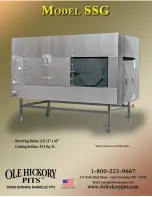
8
Wiring Requirements
• This smoke alarm must be installed with an AS/NZS Wiring Rules
approved cable or equipment. All connections must be installed by a
qualified electrician and be in accordance with the relevant require-
ments of the AS/NZS Wiring Rules AS 3000 Standards.
• The appropriate power source is 240VAC 50Hz continuous single
phase sine wave current supplied from a non-switchable circuit which
is not protected by a RCD.
DANGER: ELECTRICAL SHOCK HAZARD. Turn off power at
the main fuse box or circuit breaker by removing the fuse or
switching the circuit breaker to the OFF position and securing
it.
5. Installation
WARNING: THIS SMOKE ALARM MUST BE INSTALLED BY
QUALIFIED (LICENSED) ELECTRICIANS ONLY.
WARNING: This alarm cannot be operated from power derived
from a square wave or modified square wave inverter. These type of
inverters are sometimes used to supply power to the structure in off grid
installations, such as solar or wind derived power sources. These
power sources produce high peak voltages that will damage the alarm.
Wiring Instructions
Caution! Turn off the main power to the circuit before wiring
the alarm.
• For alarms that are used as single station, interconnect cable
terminal (I/C) on alarm is unused.
• When alarms are hardwired interconnected, all hardwire
interconnected units must be powered from a single AC circuit.
• A maximum of 24 Quell safety devices may be hardwire
interconnected in a multiple station arrangement. The hardware
interconnect system should not exceed the interconnect limit of
24 units.
• The maximum wire run distance between the first and last unit in an
interconnected system is 250 meters and installed in accordance
with AS\NZS 3000. Figure 3 illustrates interconnection wiring.
Improper connection will result in damage to the alarm, failure to
operate, or electrical shock hazard..
• Make certain alarms are wired to a continuous (non-switched) final
sub-circuit.
• Do not hardwire interconnect the wireless alarm to another wireless
interconnected smoke alarm.
!
!
!
!











































